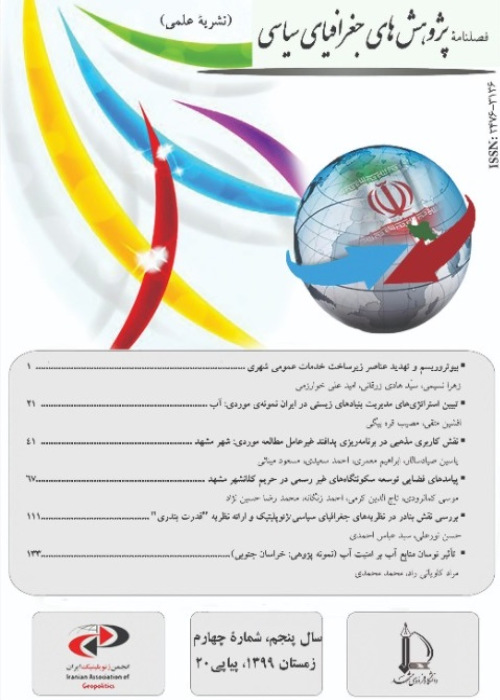The Role of Trade Liberation and Regional Economic Cooperation in Development and Security: Case Study of Southern African Development Community (SADC)
Author(s):
Article Type:
Research/Original Article (دارای رتبه معتبر)
Abstract:
Introduction
Security and development are among the most prominent issues and concerns of countries and political players. In this regard, economists believe that free trade among countries can act as the impelling force in both development and security. Nowadays, especially after the disintegration of the Soviet Union and the disappearance of the bipolar system, the expansion of external trade in the globalized world bears an exclusive position, whereas the release of trade markets has turned into the globalization symbol. Indeed, the regional integration process was shifted and strengthened to meet the needs and objectives of the various groups and regions, and in the realm of activity, a significant number of regional economic organizations were formed and demonstrated during this period.Signing General Agreement on Tariffs and Trade (GATT) and turning it into the World Trade Organization indicates the role of free trade and causing dependency among the countries. The regional convergence trend changed its direction in order to provide for the needs and purposes of groups and different geographical areas. As it was strengthened, practically a considerable number of regional economic organizations were established during this era showing that the economic power has become an important constituent element within political power, and even the military power in the international scope. The supporters of convergence believe that the opportunity provided by trade for a poor country, with the purpose of making up for the internal shortages, overcomes the losses due to the small size of the internal markets, accelerating its economical level of learning. In this respect, countries have focused on the principle of tending to regions as a result of the principle regarding the neighborhood and similarity and with the target of reducing the damages of globalization. They assume this is in line with the principle of becoming powerful.
Method
This research survived the impact of trade rules and regional economic convergence through the case study of Southern African Development Community (SADC) with an analytical method combined with statistical data.
3 .Results and Discussion
Africa is one of the world's richest regions, despite all its problems and challenges. According to numerous experts, Africa's broad sources are essentially vital for production of regional trending and globalization. The countries of this continent, just like many of the developing countries are keen on reducing their damages to the minimum level; therefore, they have considered regional convergence as a major tool in economic progress, intending to find a solution for their main concerns which are development, welfare and safety. The SADC goals in the first decade were to focus on political and security issues. Accordingly, the main goal was to reduce South Africa's dependence through regional cooperation and development. In the 1990s, with the end of apartheid and South Africa's membership, the issue of economic development was prioritized by SADC. In line with its economic goals and policies, the organization signed the SADC Commercial Code in 1996 and implemented it in 2000. This set of programs was launched in 2003 to accelerate economic convergence including strengthening interregional trade through trade liberalization, strengthening economic development in member countries, self-sufficiency in resources and establishing a free trade area. The relative liberalization of the SADC region has accelerated in comparison with other regional organizations of the African continent. For example, in 2013 the global export rate was about 20%, while that figure for South Africa and the South African Customs Union was 30%. This figure shows trade liberalization towards the 1990s.
4.Conclusion
Trade liberalism in the Southern African Development Community (SADC) in comparison with another regional organization in Africa had accelerated. For example, in 2013, the world export rate has been 20 percent, but this data in SADC Region shares was 30 percent. In other words, the trade trends from 1995 until now show the increase of SADC Region share in the world trade from 1.5 to 2.1. It must be noted that this development originated from the attempts of South Africa after apartheid and change of geopolitics of war into the geopolitics of peace.Keywords:
Language:
Persian
Published:
Research Political Geography, Volume:2 Issue: 4, 2018
Pages:
87 to 116
magiran.com/p2007206
دانلود و مطالعه متن این مقاله با یکی از روشهای زیر امکان پذیر است:
اشتراک شخصی
با عضویت و پرداخت آنلاین حق اشتراک یکساله به مبلغ 1,390,000ريال میتوانید 70 عنوان مطلب دانلود کنید!
اشتراک سازمانی
به کتابخانه دانشگاه یا محل کار خود پیشنهاد کنید تا اشتراک سازمانی این پایگاه را برای دسترسی نامحدود همه کاربران به متن مطالب تهیه نمایند!
توجه!
- حق عضویت دریافتی صرف حمایت از نشریات عضو و نگهداری، تکمیل و توسعه مگیران میشود.
- پرداخت حق اشتراک و دانلود مقالات اجازه بازنشر آن در سایر رسانههای چاپی و دیجیتال را به کاربر نمیدهد.
In order to view content subscription is required
Personal subscription
Subscribe magiran.com for 70 € euros via PayPal and download 70 articles during a year.
Organization subscription
Please contact us to subscribe your university or library for unlimited access!



